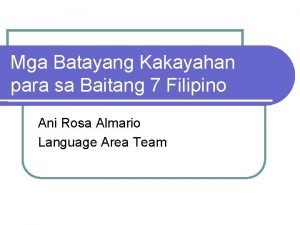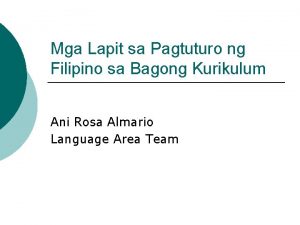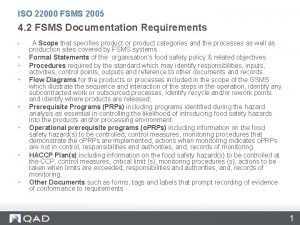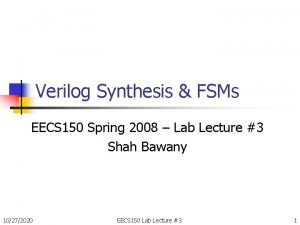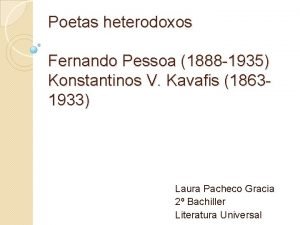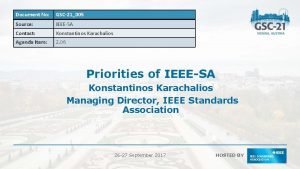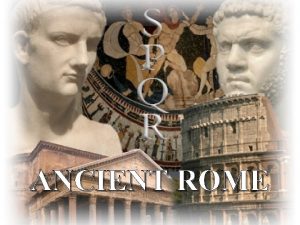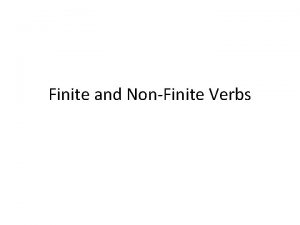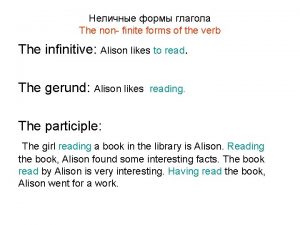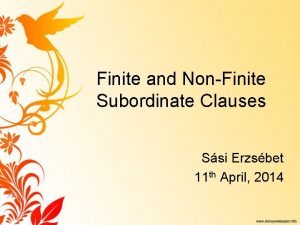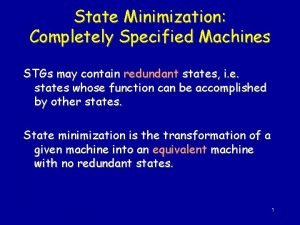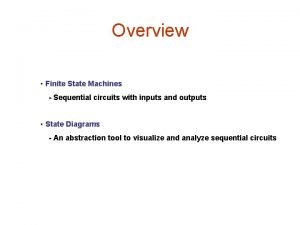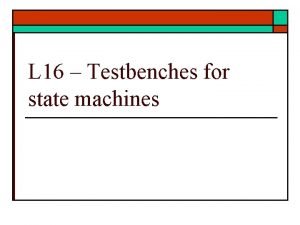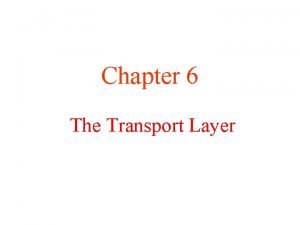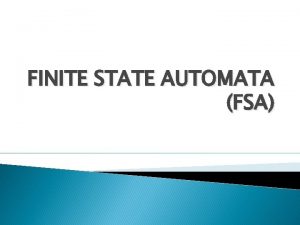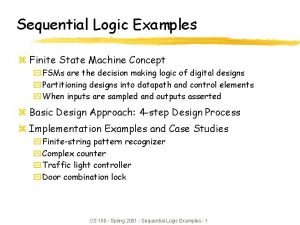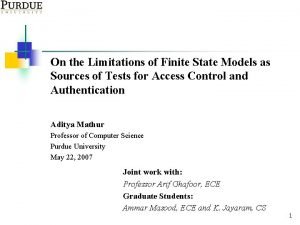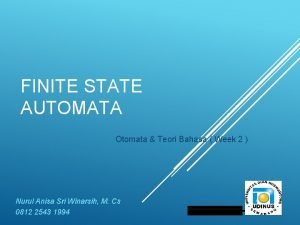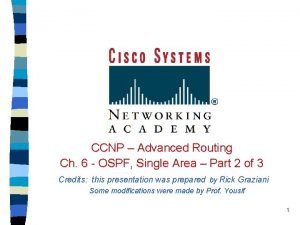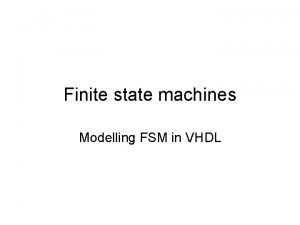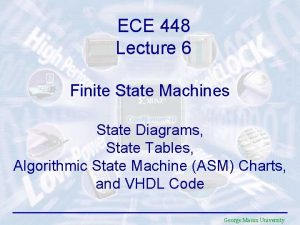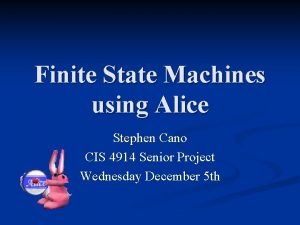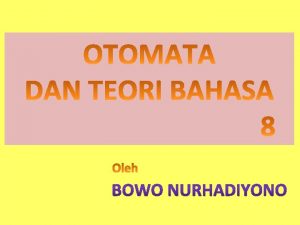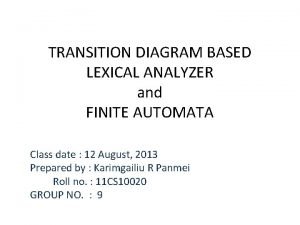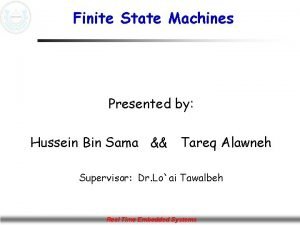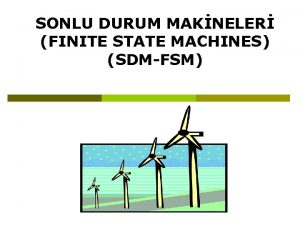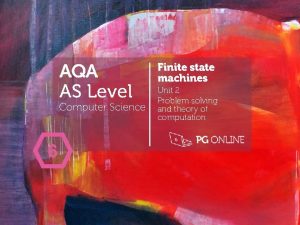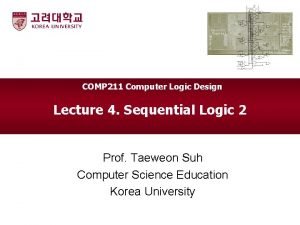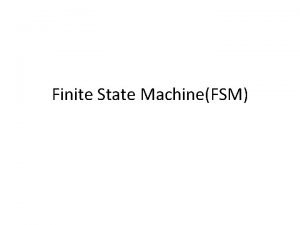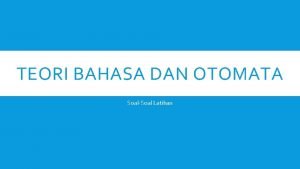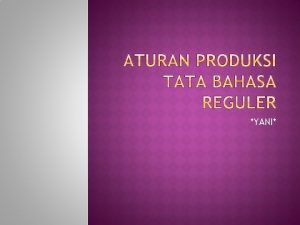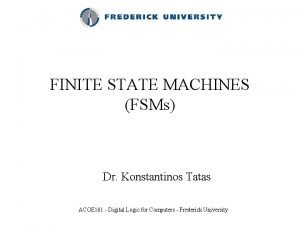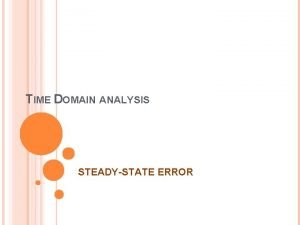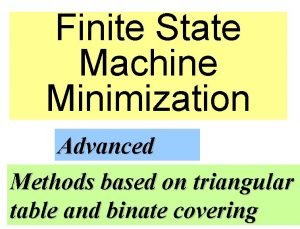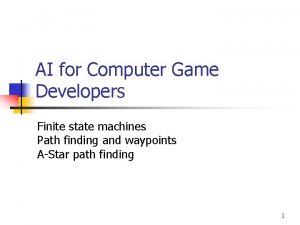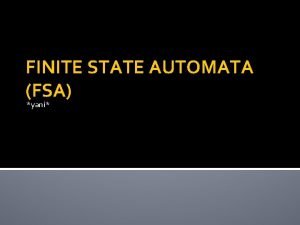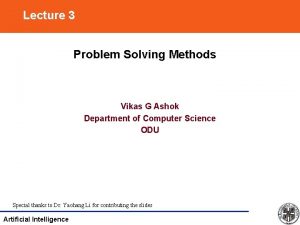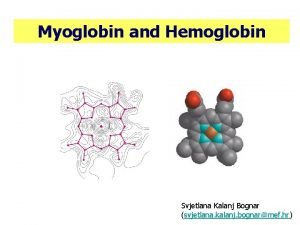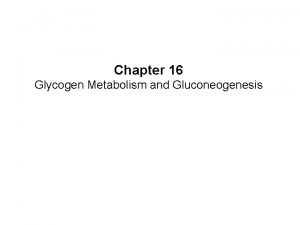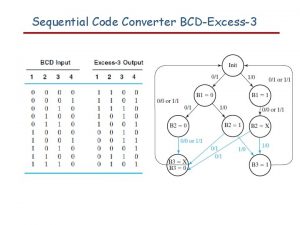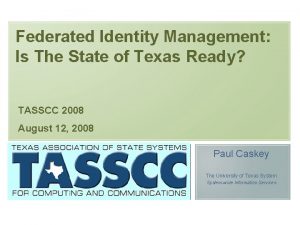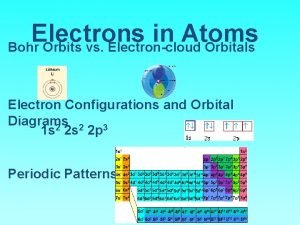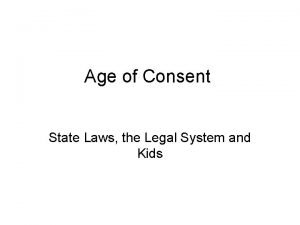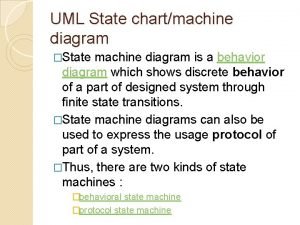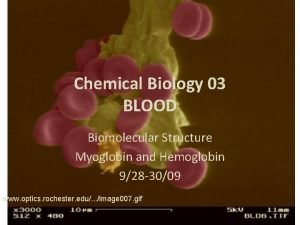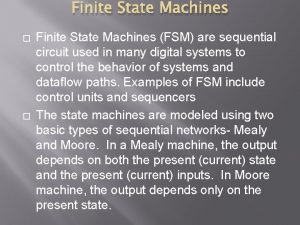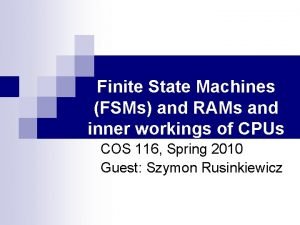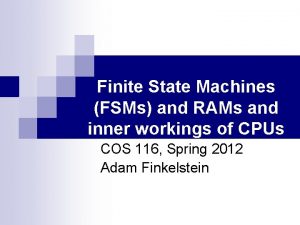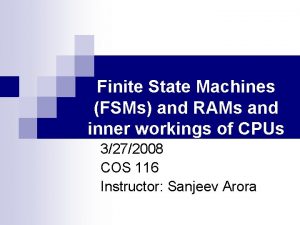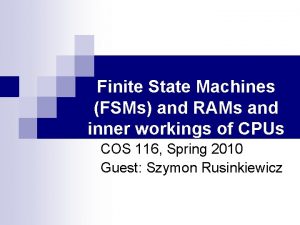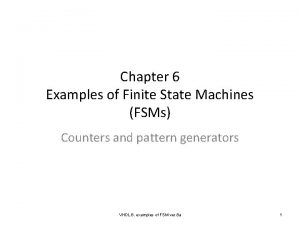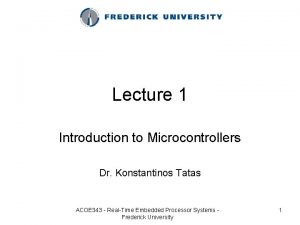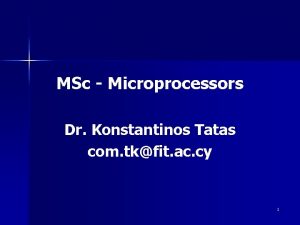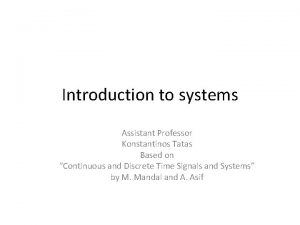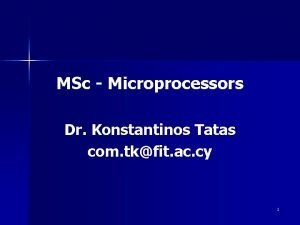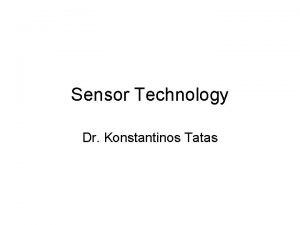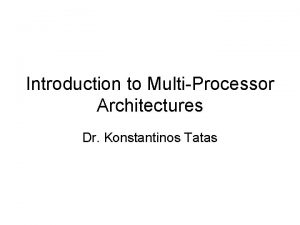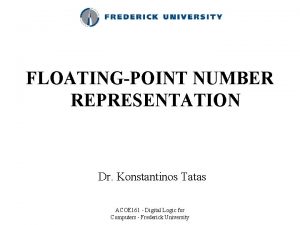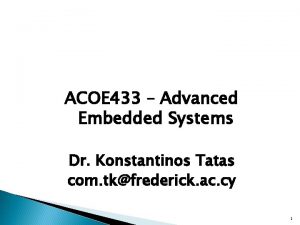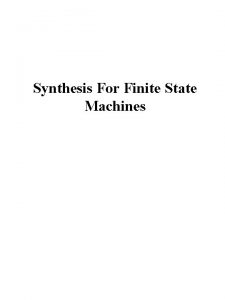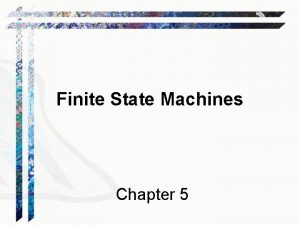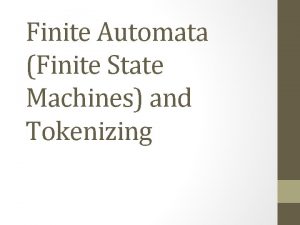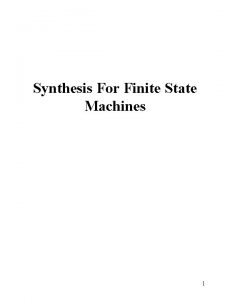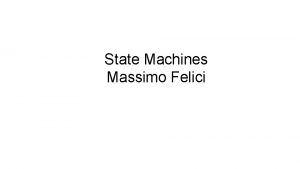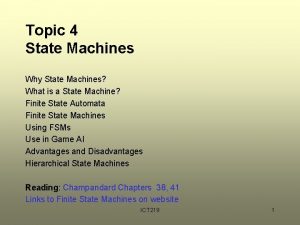FINITE STATE MACHINES FSMs Dr Konstantinos Tatas Finite






























































- Slides: 62

FINITE STATE MACHINES (FSMs) Dr. Konstantinos Tatas

Finite State Machine • A generic model for sequential circuits used in sequential circuit design ACOE 161 - Digital Logic for Computers - Frederick University

Finite state machine block diagram • State memory: Set of n flip-flops that hold the state of the machine (up to 2^n distinct states) • Next state logic: Combinational circuit that determines the next state as a function of the current state and the input • Output logic: Combinational circuit that determines the output as a function of the current state and the input ACOE 161 - Digital Logic for Computers - Frederick University

Finite State Machine types • Mealy machine: The output depends on the current state and input • Moore machine: The output depends only on the current state – State = output state machine: A Moore type FSM where the current state is the output ACOE 161 - Digital Logic for Computers - Frederick University

State diagram A state diagram represents the states as circles and the transitions between them as arrows annotated with inputs and outputs ACOE 161 - Digital Logic for Computers - Frederick University

Analysis of FSMs with D flip-flops • Determine the next state and output functions • Use the functions to create a state/output table that specifies every possible next state and output for any combination of current state and input ACOE 161 - Digital Logic for Computers - Frederick University

EXAMPLE ACOE 161 - Digital Logic for Computers - Frederick University

Next state equations and state table for example • A+=Ax+Bx • B+=A΄x • Y=(A+B)x΄ A B x A+ B+ y 0 0 0 0 1 0 0 0 1 1 1 1 0 0 0 0 1 1 0 0 0 1 1 1 0 0 ACOE 161 - Digital Logic for Computers - Frederick University

• A+=Ax+Bx • B+=A΄x • Y=(A+B)x΄ A B x 0 0 0 1 1 1 0 0 1 1 1 ACOE 161 - Digital Logic for Computers - Frederick University A+ B+ y

Sequential circuit design methodology • From the description of the functionality or the state/timing diagram find the state table • Encode the states if the state table contains letters • Find the necessary number of flip-flops • Select flip/flop type • From the state table, find the excitation tables and output tables • Using Karnaugh maps find the flip-flop input logic expressions • Draw the circuit logic diagram ACOE 161 - Digital Logic for Computers - Frederick University

Example: Design the sequential circuit of the following state diagram ACOE 161 - Digital Logic for Computers - Frederick University

State/excitation table A B x A+ B+ DA DB JA KA JB KB 0 0 0 0 0 1 0 1 0 0 1 1 1 0 0 1 0 1 1 1 0 1 1 1 ACOE 161 - Digital Logic for Computers - Frederick University

Karnaugh maps for combinational circuit ACOE 161 - Digital Logic for Computers - Frederick University

Circuit logic diagram ACOE 161 - Digital Logic for Computers - Frederick University

Example: counter ACOE 161 - Digital Logic for Computers - Frederick University

Self-correcting state machines • The previous example did not include two possible states “ 011” and “ 111”. If the counter unexpectedly falls into one of those states there are two possibilities: – The counter will recover by entering a valid state after a finite number of cycles (self-correcting) – The counter will stay in a non-valid state until the f/fs are reset (not self-correcting) • Finite state machines should be designed to be self correcting by assigning non-valid states to a valid next state (no don’t cares in the excitation table) ACOE 161 - Digital Logic for Computers - Frederick University

Example • Design a self-correcting one-digit BCD counter ACOE 161 - Digital Logic for Computers - Frederick University

State minimization/assignment • Often the state of the circuit is not also the output and therefore the states are named abstractly • State minimization and state assignment are then required • State minimization is the simplification of the state diagram so that a circuit with less states produces the same output sequence • State assignment is the process of assigning a binary number to each state ACOE 161 - Digital Logic for Computers - Frederick University

Example • State values are not important just the input/output sequence • States are symbolized with letters ACOE 161 - Digital Logic for Computers - Frederick University

State table Current state Input Next state Output a 0 a 1 b 0 c 0 b 1 d 0 c 0 a 0 c 1 d 0 e 0 d 1 f 1 e 0 a 0 e 1 f 0 g 0 f 1 g 0 a 0 g 1 f 1 ACOE 161 - Digital Logic for Computers - Frederick University

State equivalence • Two states are equivalent if for any element of the input set both produce the same output and send the circuit to the same state or an equivalent one. • One of the two equivalent states can be eliminated from the state diagram Current state Input Next state Output a 0 a 1 b 0 c 0 b 1 d 0 c 0 a 0 c 1 d 0 e 0 d 1 f 1 e 0 a 0 e 1 f 0 g 0 f 1 g 0 a 0 g 1 f 1 ACOE 161 - Digital Logic for Computers - Frederick University

State minimization Current state Input Next state Output a 0 a 1 b 0 c 0 b 1 d 0 c 0 a 0 c 1 d 0 e 0 d 1 f d 1 e 0 a 0 e 1 fd 1 f 0 g e 0 f 1 g 0 a 0 g 1 f 1 ACOE 161 - Digital Logic for Computers - Frederick University

State assignment • Since we don’t care about the actual flip-flop values for each state we can assign each state to any binary number we like as long as each state is assigned a unique binary number • If we use 3 bits to encode the states, we have possible encodings state Encoding 1 2 3 (binary) (Gray) a 000 000 b 001 100 c 010 011 010 d 011 010 101 e 100 110 011 ACOE 161 - Digital Logic for Computers - Frederick University

One-hot encoding • One flip-flop per state encoding • Leads to greater number of flip-flops than binary encoding but possibly to simpler logic state Encoding 1 (binary) Encoding 3 2 (Gray) (one-hot) a 000 00001 b 001 00010 c 010 011 00100 d 011 01000 e 100 110 10000 ACOE 161 - Digital Logic for Computers - Frederick University

Algorithmic State Machines

Introduction Digital system is specified by the following three components: • The set of registers in the system • The operations that are performed on the data stored in the registers. • The control that supervises the sequences of operations in the system. ACOE 161 - Digital Logic for Computers - Frederick University

Control and Datapath Interaction ACOE 161 - Digital Logic for Computers - Frederick University

Datapath • Binary information in digital systems classified as either data or control. • Data – bits of information manipulated by performing arithmetic and logic operations. • Hardware components realizing above operations are adders, decoders, multiplexers, counters e. t. c ACOE 161 - Digital Logic for Computers - Frederick University

Control Path • Command signals used to supervise execution of algorithms by datapath. • Bi-directional communication with datapath through status conditions used to determine the sequence of control signals. • Control logic inherently sequential. • Control logic is usually implemented using FSMs ACOE 161 - Digital Logic for Computers - Frederick University

Algorithm Implementation • Often we have to implement an algorithm in hardware instead of software • Algorithm is a well defined procedure consisting of a finite number of steps to the solution of a problem. • It is often hard to translate the algorithm into an FSM. • ASMs can serve as stand-alone sequential network model. ACOE 161 - Digital Logic for Computers - Frederick University

Algorithmic State Machine • Used to graphically describe the operations of an FSM more concisely • Resembles conventional flowcharts – differs in interpretation. • Conventional flowchart – sequential way of representing procedural steps and decision paths for algorithm -No time relations incorporated • ASM chart – representation of sequence of events together with timing relations between states of sequential controller and events occurring while moving between steps ACOE 161 - Digital Logic for Computers - Frederick University

ASM Chart • Three basic elements: state box, decision box and conditional box -State and decision boxes used in conventional flowcharts -Conditional box characteristic to ASM • State box -Used to indicate states in control sequence • Register operations and output signals used to control generation of next state written ACOE 161 - Digital Logic for Computers - Frederick University

State box • Represents one state in the ASM. • May have an optional state output list. • Single entry. • Single exit to state or decision boxes. ACOE 161 - Digital Logic for Computers - Frederick University

State Box State name T 3 • Binary code of T 3 – 011 • Register operation R <- 0 • START – name of outputs signal generated in this stage ACOE 161 - Digital Logic for Computers - Frederick University

Decision box • Provides for next alternatives and conditional outputs. • Conditional output based on logic value of Boolean expression involving external input variables and status information. • Single entry. • Dual exit, denoting if Boolean expression is true or false. • Exits to decision, state or conditional boxes. ACOE 161 - Digital Logic for Computers - Frederick University

Decision Box • Input condition subject to test inside diamond shape box • Two or more outputs represent exit paths dependant on value of condition in decision box • Two paths for binary based conditions ACOE 161 - Digital Logic for Computers - Frederick University

Conditional output box • Provides a listing of output variables that are to have a value logic-1, i. e. , those output variables being asserted. • Single entry from decision box. • Single exit to decision or state box. ACOE 161 - Digital Logic for Computers - Frederick University

Conditional Box • In state T 1 Output signal START generated Status of input E checked • If E = 1, R <- 0, otherwise remains unchanged • Conditional operation executed depending on result of coming from decision box ACOE 161 - Digital Logic for Computers - Frederick University

ASM Block • Consists of the interconnection of a single state box along with one or more decision and/or conditional boxes. • It has one entry path which leads directly to its state box, and one or more exit paths. • Each exit path must lead directly to a state, including the state box in itself. • A path through an ASM block from its state box to an exit path is called a link path. ACOE 161 - Digital Logic for Computers - Frederick University

Timing Considerations All sequential elements in datapath and control path controlled by master-clock generator. Does not necessarily imply single clock in design. • Multiple clocks can be obtained through division of clock signals from master-clock generator. • Not only internal signals, but also inputs synchronized with clock. • Normally, inputs supplied by other devices working with the same master clock. • Some inputs can arrive asynchronously Difficult to handle by synchronous designs, require asynchronous glue-logic. ACOE 161 - Digital Logic for Computers - Frederick University

• In conventional flowchart, evaluation of each chart element takes one clock cycle ASM Block Step 1: Reg A incremented Step 2: Condition E evaluated Step 3: Based on evaluation results, state T 2, T 3 or T 4 entered • In ASM the entire block considered as one unit • All operations within block occurring during single edge transition The next state evaluated during the same clock System enters next. ACOE 161 - Digital Logic for Computers - Frederick University state T 2, T 3 or T 4 during transition of next clock

ASM Block • An ASM block describes the operation of the system during the state time in which it is in the state associated with the block. • The outputs listed in the state box are asserted. • The conditions indicated in the decision boxes are evaluated simultaneously to determine which link path is to be followed. • If a conditional box is found in the selected path then the outputs found in its output list are asserted. • Boolean expression may be written for each link path. The selected link paths are those that evaluate to logic-1. ACOE 161 - Digital Logic for Computers - Frederick University

Example 2 • Extract the FSM diagram from the ASM diagram ACOE 161 - Digital Logic for Computers - Frederick University

Example • Design a circuit that implements the following pseudocode: a=0; for (i=0; i<5; i++) if b=0 then //boolean a = a+i; out = a; else out = a-i; ACOE 161 - Digital Logic for Computers - Frederick University

Control/datapath partitioning a=0; for (i=0; i<5; i++) if b=0 then a = a+i; out = a; else out = a-i; External control inputs: b Input data: a, i Status conditions: i< 5 Commands: i++, a = a+i, out=a, out=a-i ACOE 161 - Digital Logic for Computers - Frederick University

Datapath design a=0; // register for a for (i=0; i<5; i++)// adder for i++ if b=0 then a = a+i; //adder for a+i out = a; else out = a-i; //adder for a-i //mux for out ACOE 161 - Digital Logic for Computers - Frederick University

Datapath design ACOE 161 - Digital Logic for Computers - Frederick University

ASM chart If: S 0=0 (out=a) Else: S 0=1 (out =a-i) Load: S 2 S 1=00 (a=0) If : S 2 S 1=10 (a=a+i) Else: S 2 S 1=01 (a=a) Load: S 3=0 (i=0) If, else: S 3=1 (i++) ACOE 161 - Digital Logic for Computers - Frederick University

Control logic design • State Diagram • State encoding: • Load: 00 • If: 01 • Else: 10 • End: 11 ACOE 161 - Digital Logic for Computers - Frederick University

State/ excitation table A B b fin A+ B+ S 0 S 1 S 2 S 3 0 0 0 1 X 0 0 0 1 0 X 0 0 0 1 1 1 0 X 0 0 1 0 0 0 1 1 1 0 0 1 1 0 1 0 0 0 1 1 1 1 1 0 0 0 0 0 1 1 1 0 1 0 0 0 1 1 1 0 1 1 1 0 0 1 1 X X 1 1 0 1 1 1 X X 1 1 1 0 1 1 X X 1 1 1 X X ACOE 161 - Digital Logic for Computers - Frederick University

ASM versus FSM ACOE 161 - Digital Logic for Computers - Frederick University

Timing of Transition Between States During single clock cycle • Reg A incremented Condition E evaluated • If E=1 then R <-0 • Control transferred to state T 2, T 3 or T 4 • Control path and datapath work simultaneously ACOE 161 - Digital Logic for Computers - Frederick University

Design Example – Initial Spec • Hardware spec: -Two DFFs (E and F) and one 4 -bit binary counter A DFFs in A referred to as A 4, A 3, A 2 and A 1 -A 4 stores MSB, A 1 LSB • Operation spec: Start signal S = 1 -A 4 -A 1 regs cleared (counter set to 0) -F reg cleared • From next clock cycle counter increments by one every clock cycle until operation stops ACOE 161 - Digital Logic for Computers - Frederick University

ASM Chart Three states and three blocks ACOE 161 - Digital Logic for Computers - Frederick University

Timing Sequence • Operation in each ASM block executed in one clock cycle -Operations in state and conditional boxes executed by datapath -Changes from one state to other performed in by control path ACOE 161 - Digital Logic for Computers - Frederick University

Design Example Two Flip-Flops (E, F) and one 4 -bit counter A. The system is initiated by a start Signal S, by clearing the counter A And flip-flop F. The counter is then Incremented by one starting for the next clock and continues to increment Until the operations stop. Bits A 3 and A 4 Determine the sequence of operations: 1. 2. 3. If A 3=0, E is cleared to 0 and the count continues. If A 3=1, E is set to 1; then if A 4=0, the count continues, but if A 4=1, F is set to 1 on the next clock pulse and the system stops counting. Then if S=0, the system remains in the initial state, but if S=1, the operation cycle repeats. ACOE 161 - Digital Logic for Computers - Frederick University

Sequence of Operations • Upon entering T 1 E=1 (no change from T 0), F=0 (cleared in T 0, S=1) • System in T 1 for 13 clocks -At each clock counter incremented -Depending on current state of A 3 and A 4 E cleared or set • When A 3, A 4=1 state T 2 entered -Controller in T 2 for one clock -As A 3=1, F=1, state T 0 entered • System in state T 0 until S =1 ACOE 161 - Digital Logic for Computers - Frederick University

State Table • Many minimization methods of sequential circuits involve circuit description in form of state table • Number of states in ASM determines number of DFFs implementing states -n flip-flops result in 2 n states -Three states in ASM – two flip-flops needed • State diagram converted into state table • Controller state table – list of present states and inputs, with corresponding next states and outputs -Don’t care conditions used for hardware minimization ACOE 161 - Digital Logic for Computers - Frederick University

State Table, cont. • Example: T 0 = 00, T 1 = 01, T 2 = 11 -State 10 not used (don’t care assignment) • Flip-flops represented states labeled G 1 and G 0 • Three inputs and three outputs -Inputs taken from conditions in decision boxes -Outputs equivalent to present states of controller ACOE 161 - Digital Logic for Computers - Frederick University

State Table, cont. ACOE 161 - Digital Logic for Computers - Frederick University

Datapath Design ACOE 161 - Digital Logic for Computers - Frederick University

Register Transfer Representation ACOE 161 - Digital Logic for Computers - Frederick University
 Batayan sa pagsulat ng tekstong nagsasalaysay
Batayan sa pagsulat ng tekstong nagsasalaysay Sinasabing walang pagbasa kung walang pag unawa
Sinasabing walang pagbasa kung walang pag unawa Mga uri ng panitikan
Mga uri ng panitikan Prps food safety
Prps food safety Iso 22000 fsms 2005
Iso 22000 fsms 2005 Fsms 2020
Fsms 2020 Fbisd fsms
Fbisd fsms Fsms 2020
Fsms 2020 Konstantinos karachalios
Konstantinos karachalios Konstantinos kavafis biografia
Konstantinos kavafis biografia Nikos vertis biography
Nikos vertis biography Konstantinos karachalios
Konstantinos karachalios Teepc
Teepc Konstantinos
Konstantinos Learning objectives of non finite verbs
Learning objectives of non finite verbs Finite and nonfinite verbs
Finite and nonfinite verbs Finite and non finite
Finite and non finite Learning objectives for finite and non finite verbs
Learning objectives for finite and non finite verbs Finite subordinate clauses
Finite subordinate clauses State machines digital electronics
State machines digital electronics In an incompletely specified machine
In an incompletely specified machine Finite state machine sequential circuits
Finite state machine sequential circuits Finite state machine vhdl testbench
Finite state machine vhdl testbench Deterministic finite state automata
Deterministic finite state automata Finite state machine
Finite state machine Tcp connection management finite state machine
Tcp connection management finite state machine Finite automata dikelompokkan menjadi
Finite automata dikelompokkan menjadi Finite
Finite Finite state machine vending machine example
Finite state machine vending machine example Limitations of finite automata
Limitations of finite automata Contoh kasus finite state automata
Contoh kasus finite state automata Ospf finite state machine
Ospf finite state machine Types of fsm
Types of fsm Vhdl finite state machine
Vhdl finite state machine Maximum segment size
Maximum segment size Cis4914
Cis4914 Mesin mealy adalah
Mesin mealy adalah Transition graph in automata
Transition graph in automata Finite state machine with datapath
Finite state machine with datapath Sonlu durum makinesi örnekleri
Sonlu durum makinesi örnekleri Finite state machine
Finite state machine Traffic light finite state machine
Traffic light finite state machine 3 floor elevator fsm
3 floor elevator fsm Contoh soal dan jawaban teori bahasa dan automata
Contoh soal dan jawaban teori bahasa dan automata Contoh tata bahasa reguler
Contoh tata bahasa reguler Finite state machine
Finite state machine Steady state error in control system
Steady state error in control system Finite state machine minimization
Finite state machine minimization Finite state machine game
Finite state machine game Finite state automata didefinisikan dengan?
Finite state automata didefinisikan dengan? What is initial state + goal state in search terminology?
What is initial state + goal state in search terminology? T state vs r state
T state vs r state Glycogen regulation
Glycogen regulation Equivalent state
Equivalent state State to state regionalism
State to state regionalism Tasscc state of the state
Tasscc state of the state Shell and subshell
Shell and subshell Age of consent per state
Age of consent per state Present state desired state
Present state desired state Sr ff excitation table
Sr ff excitation table Behavioral state machine diagram
Behavioral state machine diagram T state vs r state
T state vs r state State state graphs and transition testing
State state graphs and transition testing
